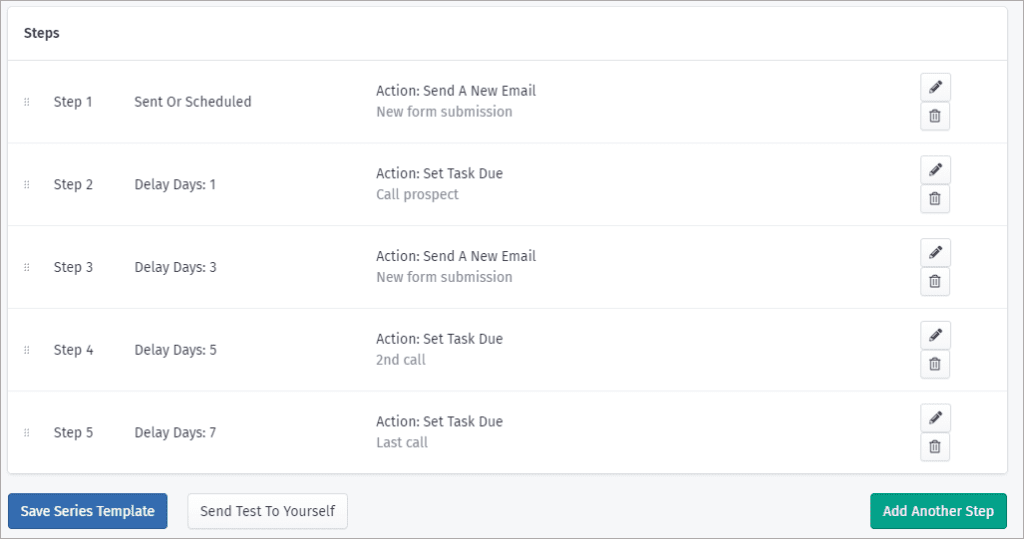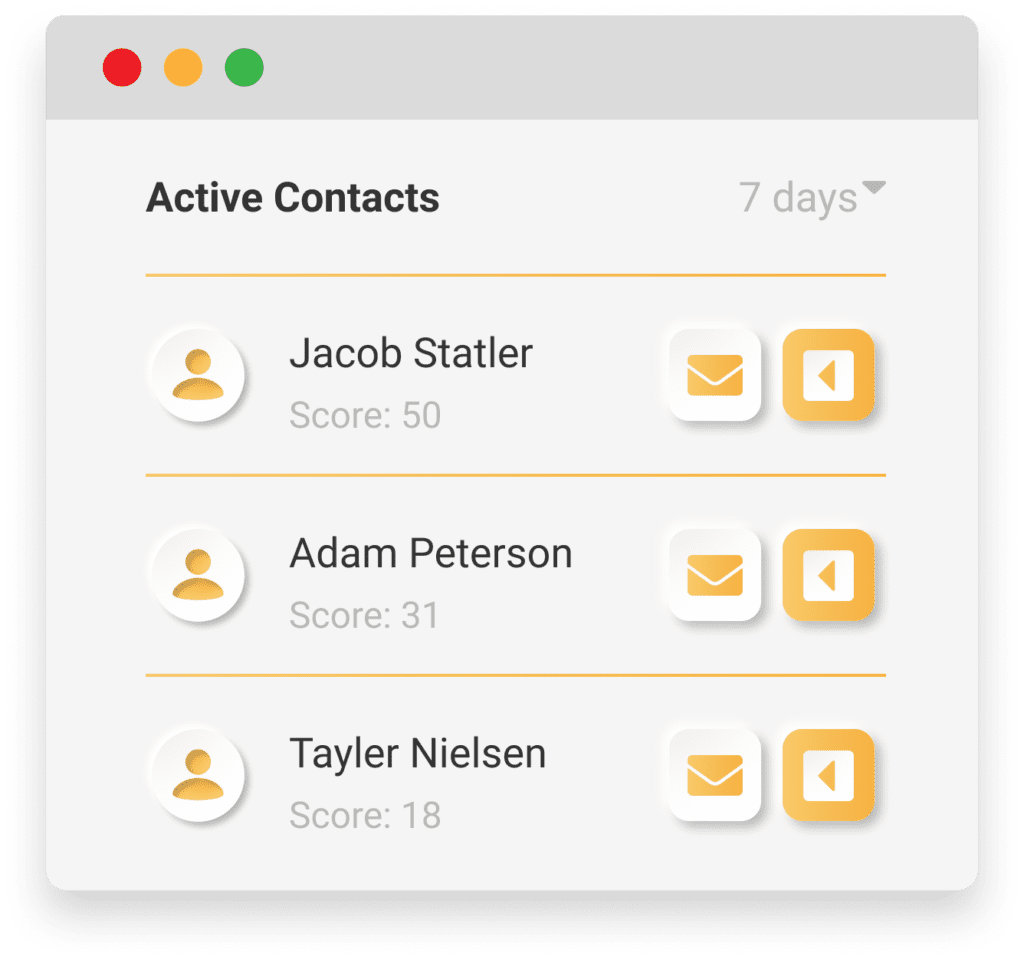Last updated on August 3rd, 2023

If your business is in the B2B space, this post has practical strategies to help you capitalize on marketing automation opportunities by using the right technology.
As technology develops and customers start to demand better experiences, more companies are leveraging marketing automation technology.
Relevancy and personalization are a necessity when it comes to marketing to B2B customers at scale.
CRM and automation tools can help make marketing at scale to high-value leads much more practical.
Let’s go over how.
Table of Contents:
- How Does Marketing Automation Work From A B2B Standpoint?
- B2B Vs. B2C Marketing Automation: What Is The Difference Between Both?
- What Are Ways To Automate B2B Marketing?
- How Does CRM Tie Into Marketing Automation Flow?
- Final Thoughts On Marketing Automation For B2B

VipeCloud is the only Automation tool your small business needs to
be the hero to your customers.
With Email, Texting, Social, Suites, Chat, Stories, Video Email & Sign Up Forms fully built-in, we provide you with the perfect platform to grow your business.
15 Day Free Trial – Get started risk free. No CC needed.
How Does Marketing Automation Work From A B2B Standpoint?
Marketing automation uses a special type of technology (typically CRM) that allows you to:
- Market at scale to an audience while staying relevant
- Measure your results
- Schedule and repeat marketing workflows
- Save you time on repetitive marketing tasks
Marketing automation also helps to generate sales opportunities and track them.
I’ll give you an example:
When a company is automating their emails, they can use the email tracking to gauge how their campaigns are doing week-in and week-out.
The email data (tracking) will help them determine which templates, subject lines, and CTAs they should stick to (since they generate opportunities) and which ones to toss out.

If they’re driving lead traffic to a landing page form, they can set an Autoresponder that sends emails to leads throughout the month with delays in between.
After doing so for a quarter, they can note any improvements in their metrics.
These are just two examples of how B2B companies could practically use marketing automation tools
53% of B2B organizations are already implementing marketing automation, and 37% plan to do so.
B2B Vs. B2C Marketing Automation: What Is The Difference Between Both?
The way B2B goes about marketing automation will differ from B2C.
Why?
B2B customers have different expectations.
So, to help you understand the differences, let’s compare the two.
B2B companies have to keep a closer eye on their potential deals because they typically experience longer sales cycles and have higher ticket offers.
On top of that, B2B companies usually sell to a niche pool of other companies.
B2C is the opposite.
B2C companies typically have lower ticket offers, shorter sales cycles, and bigger customer pools.
Put simply, the buying process of a consumer can be as quick as a snap of a finger, whereas a president of a large company may have to consult their board.
So it’d only make sense that they market differently, right?
With longer sales cycles in the B2B space, it stands to reason that a closer relationship needs to be built with the buyer (especially if the relationship is ongoing.)
So B2B marketing automation campaigns will last for more extended periods and include more effort.
This could include:
- Automations to nurture prospects by educating them
- Automations to show offers
- More dynamic touch points across different platforms for months on end
What Are Ways To Automate B2B Marketing?
1. Lead Nurturing
Lead nurturing is when you use channels like SMS, email marketing, and social to stay top-of-mind.
This is crucial because B2B prospects need to be educated about your offer and trust it before they’re willing to buy (other factors play a role too.)
If you’re using email, you can segment your leads into different categories in your CRM and follow up with targeted content.
Content that:
- Educates
- Sells your product (case studies, benefits-based copy, product features)
- Starts a conversation

Once you feel like they’re growing warmer, they can go from an MQL to a SQL.
As an SQL, they’re ready to connect with a human salesperson who can elaborate on the marketing.
Here are some examples of how you can use marketing automation for lead nurturing:
- “Welcome email” sequences that introduce them to your brand and products.
- Delayed text message campaigns reminding them to book a call after submitting a form.
- Forms that send a series of email sequences after submission
- Email sequences following gated content: including webinar sign-ups, a free course, or free downloadables.
- Sequences for specific lead activity such as clicks, email opens, and page visits (triggered emails have a click-through rate of 152% higher than traditional emails!)
2. Lead Scoring
You may think this automation ranking system is closer to sales, but it has merits in marketing too.
How?
Lead scoring helps rank the interest of your leads as you market to them.
Allowing you to tangibly know who’s the ideal fit without having to guess because you’re basing their score off of:
- Demographic match to your ideal customers
- Behavioral match to your ideal customers

By scoring leads, you can time and target your marketing to fit what prospects are looking for.

For instance, someone with a high lead score is probably sales-ready and can be targeted with more direct, CTA-based marketing.
Someone a little higher on your funnel, an MQL ranked lead, will maybe benefit from more educational content for the time being.
The takeaway is this:
Lead scoring can help target the right leads with the right content.
And at the same time, it systemizes how you identify a “quality lead,” taking the guesswork out of who is right for your business and who isn’t.
3. Multi-Channel Campaigns
52% of marketers use 3 to 4 marketing channels.
Multi-channel campaigns are automation put in place for different marketing avenues.
Think of the ones mentioned earlier: email, text message, and social media automation.
When you’re first using marketing automation, you might want to start with 1 channel and focus on perfecting your approach.
From there, you can move on to other channels and so on, based on available time and team members.
Multi-channel marketing allows you to make your touchpoints more dynamic and meet prospects on their preferred platforms.
Sometimes social media is where you’ll get the best results.
And other times it may be email marketing.
A lot of times, it can be a mixture of SMS, email, and social media.
This is part of why VipeCloud created an all-in-one CRM that packs these major marketing channels in one place:
By mixing-up things up, using different channels, there’s a higher likelihood of striking gold (aka someone taking action.)
Keep in mind that experimentation and measuring progress are essential.
Here’s what I mean:
You can take notes from how a competitor is marketing to an audience and test a similar approach.
Even if results are subpar with their blueprint, what you learn can spark new marketing ideas!
4. Customer Profiling & Segmentation
Marketing automation can help you update contact lists and segment customers in your CRM.
Sign-up forms are a great example of segmenting your contacts based on information they submit and shared characteristics.
By CRM automatically adding contacts to your database, it’s a huge time saver compared to manually entering information.
But this doesn’t mean manually entering information should stop.
As great as this feature is, it’s always good practice for your team to add additional information about your contacts after they’re added.
How Does CRM Tie Into Marketing Automation Flow?
Marketing automation software may be able to stand alone in your business’s arsenal.
But in B2B, building customer relationships is paramount, so focusing only on marketing automation may not be enough.
So when looking to automate marketing while establishing consistent customer relationships, nothing beats using CRM.
CRMs help improve your marketing, sales, and customer service needs by arming you with customer data that can be used to improve relationships.
Final Thoughts On Marketing Automation For B2B
B2B organizations have to take a more detailed approach to the market because it’s the best way to land today’s customers.
With longer buying cycles, B2B companies have to know where their prospects are in the buyer’s journey and the platforms they use most.
This allows their automation to fire at the right time frames with the right content to convert leads.
And as this is going on:
Tracking and measuring what’s working will help you establish sound strategies that put you above competitors.
The best way to do all of this is with VipeCloud’s Sales and Marketing Suite.
With a versatile CRM like this, you can focus on the marketing mediums that get results while synergizing your efforts with sales.
Try VipeCloud’s Sales & Marketing Suite today for 15 free days.
Got questions?
We’ll gladly answer any of them when you request a demo and see it in action!

Leave a Reply